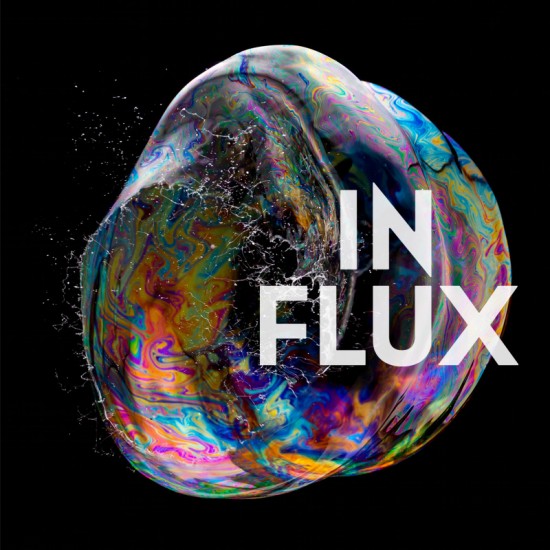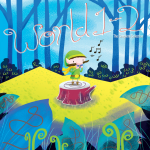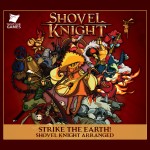
I wasn’t sure what to make of this album. I have listened to and reviewed game composers remixing game music before, but I have never reviewed an album of original compositions by game composers, that aren’t attached to any games. I admit I was dubious. Also, looking at the list of composers, I was only familiar with a few of them, most notably Akira Yamaoka, composer for the Silent Hill series. This album raised another question for me. Do I listen to game music because I associate the music with the game, or is the music good in its own right? I personally believe that there are elements of of both and I find an album comprised of original music from game composers to be very interesting. Will the music follow gaming tropes and conventions, or will the composers write music purely for the album and allow their music talents to flourish. Let’s find out what this “East meets West” album had to offer.
Track 01, “Iridescence,” is by composer Marius Masalar. I admit that I have not heard of him before and not played any of the games he has written music for, Star Command being the most popular. His track starts the album, strangely enough, like a Disney film. It’s very orchestral in style (samples) and seems to take its influence more from film rather than games. Don’t get me wrong, this track is absolutely amazing and a really good opening to an album. Masalar has a really good understanding of orchestral music and the composition is really interesting, with lovely instrumentation and a melody that evokes strong emotions. I particularly love the middle ostinato on the glockenspiel at 0’53”. It’s just very well put together and you can even hear an 8-bit synth in the background. When the soft piano melody comes back in at 1’26”, it just sounds so sweet and perfect that it makes me regret that the track is under two minutes in length.
Track 02, “Diamond,” by Monomirror, couldn’t be more different. This is a classic 8-bit style composition straight out of the NES era and, I have to admit, it’s a bit of a let-down when compared to the first track. The beginning really feels like it’s starting off the album proper, after an amazing introduction and initially I was really into it. However, as the track continued the continuously repeating harmonic progression and fairly standard beat left me bored. The fast paced background doesn’t add enough interest for me and fails to cover a rather boring song. The melody comes in at 0’57”, but, again, it is not particularly interesting and at a duration of 4’12”, it overstays its welcome. It’s not a bad track, but it’s just not particularly interesting.
Track 3, “Blue Star,” is by Japanese composer Manami Matsumae. Her most recent contributions are in Shovel Knight and the upcoming Mighty No. 9. Now, I love the music of Shovel Knight and the music of Mighty No. 9 sounds like it’s going to be great. This track, however, is nice, but a bit too bland for my likening. It starts out like something you would hear on a yoga DVD and has a distinctive Japanese lilt. An unusual beat comes in about a third of the way through, with a sampled violin, which doesn’t really add too much. At 2’14” the track completely changes into a rock ballad with electric guitars and big drums, which I like a lot. However, it repeats the same melody and harmony we have heard twice already. It’s nice, but not great.
Composer Jim Guthrie composed track 4, “Wish I Were You,” a track that he originally wrote for his album Takes Time. His most notable contribution to gaming is the Sword and Sorcery soundtrack, which I love. This track also features legendary composer Akira Yamaoka, of Silent Hill fame. As with a lot of Akira Yamaoka’s music, this track sounds like an album track, as in it doesn’t feel like it’s game influenced. It is also incredibly highly produced. There are no samples here, and the singing is excellent. The song is naturally reminiscent of some of Guthrie’s other works, but when the electric guitar counter melody kicks in, that distinctive Yamaoka sound comes right out, and I feel like I’m playing a Silent Hill all over again. This is not a bad thing; the two composers have produced an amazing arrangement that is just superb on all levels. They are a really good combination.
Track 5, “Slime Crust,” by Keiji Yamagishi comes back to the very much game inspired music. This time sounding like a game from the 16 bit era, perhaps Ghost Busters on the Genesis (Mega Drive). Yamagishi has written a lot of music for the NES, SNES and Genesis, as well as a smattering of PS1, N64, GBA and PSP games. Unfortunately I find this track to be rather boring. I can perfectly imagine it playing in the background of a 16 bit game, but even then I would have found it to be rather generic. The harmonies are simplistic, the bass is plodding, the background arpeggios are boring and all it does is repeat over and over again. Unfortunately, this track gets compared to the previous track, and it just does match up in any way.
Stemage is a prolific artist who has arranged countless tracks from the Metroid games. Stemage collaborates with Matsumae, for “Putting the Beacons to Bed,” track 6. I love how the electric guitar and piano mix as they counter balance on a semitone interval. It really gives a sense of anticipation and movement, and when the bass and drums kick in at 0’41”, I got goose bumps. Again, this track seems removed from any game era, instead reveling in a joyous song that just happens to have been written by game composers. Like the previous track, this song repeats itself a lot, but in this case the material is so well produced, with such good harmonies and cool melodies on the guitar, that I could listen to it all day. The climax half way through is a high point of the album for me.
“Manta Ray,” track 7, is by artist PolarBirds and is another 8-bit inspired retro track that, again, you would hear in a more forgettable level in a NES game. The track isn’t bad at all, and is perfectly listenable, but I feel it relies too much on nostalgia to hide some fairly basic composition. I do like the repeating bass and echoing slides of the middle section, but only because it provides a slight break in the monotony.
“Bounty Hunter,” by Eirik Suhrke is another 8-bit style track that is, however, in a completely different league to the previous track. I love it! It’s fast, exciting, and, most importantly, it’s interesting. In this case, the interest comes from the crazy melodies and staccato backing. The track starts with a fairly standard melody that is repeated a few times. The track really gets interesting for me when a higher, counter melody comes in at 0’21”, and becomes amazing at 0’33” as the melody develops a more eastern lilt. The melody just goes all over the place as well, but manages to stay coherent at the same time. The time change at 1’13” is a good technique that breaks the track in half and keeps you guessing while still repeating the main themes. The percussion and staccato harmonic are always interesting as well, meaning that you are never bored. Truly a brilliant composer.
“Shattered Moon,” track 9, is another piano and synth affair that is pleasant enough but, in my mind, doesn’t really add anything to the album. Again, this track has a far east feel that is present throughout this album.
Track 10, “Chloroplast Skin,” by Lifeformed, starts off with an off kilter beat and ethereal samples, which immediately caught my interest. However, the song doesn’t really move away from this for the entire 3’29” length. The song hinges on just two tones which repeat endlessly. This is not to say that there is no interest elsewhere. If nothing else, each repetition is different, adding extra layers, samples and rhythms. This kept me interested, but it is not something that I would listen to more than once.
Track 11, “Menacing Wonders” by Chipzel and, again, featuring Manami Matsumae, starts out like circus music with descending semitones. The harmonies of the beginning are very interesting, and don’t follow any standard chord progression. Again, this is an 8-bit style track. After the introduction a thumping beats comes in and the song really gets going. This section, I think, repeats too often, but it’s certainly epic. A melody and counter melody comes in at 1’39”. There is certainly a lot going on, with 8-bit samples coming in from left and right, and, although I didn’t find it as interesting as “Bounty Hunter,” it’s reminiscent of the most memorable songs of the 8-bit era.
The last track, “Blue Star” is by Manami Matsumae and she brings back the piano and synth that so many tracks on this album are comprised of. It sounds like a farewell song, rather than a triumphant ending. It’s a bit sad and slow and, to be honest, fairly standard. Again, there are no live instruments here, all samples, which gives it a 1980 soap opera feel. I’m not sure why a military snare is used near the end as I feel it is entirely misplaced. So, in my view, I feel that the album ends with a flop rather than a grand huzzah.
As with so many collaborative albums, the quality and scope of each track is wildly different. The album consists mostly of 8-bit nostalgia pieces or synth and piano tracks, with a few exceptional gems hidden in between. And when I say exceptional, I mean it! “Putting the Beacons to Bed” and “Bounty Hunter” are just two examples of some excellent composition from amazing composers. There is also a real mix of quality here. Some of the tracks that don’t reference computer games are great, some aren’t. Some of the 8-bit tracks are great, some aren’t. The quality comes from the artists themselves, not the style in which they write, or from their inspirations, and I’m very glad of that. There is such diversity here that I think everyone will find several tracks they will enjoy. I also think it’s good that game composers are branching out into other, purely musical endeavors. I would highly encourage gamers and non-gamers alike to give this album a try, as there is undeniable quality here. The In Flux album can be purchased on Bandcamp and iTunes.
Tags: Akira Yamaoka, Chipzel, Collaborations, Eirik Suhrke, Game Music, jim guthrie, Kenji Yamagishi, Lifeformed, Manami Matsumae, Marius Masalar, Monomirror, Music Reviews, PolarBirds, Reviews, Saori Kobayashi, Stemage, VGM








































I’m pretty sure PolarBirds had nothing to do with the Retro City Rampage soundtrack. Did you find his Bandcamp collection and mistake it for a discography?